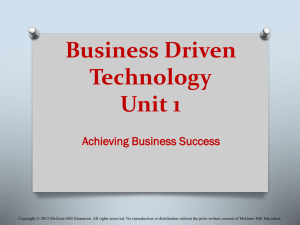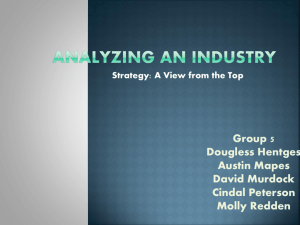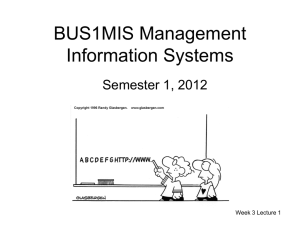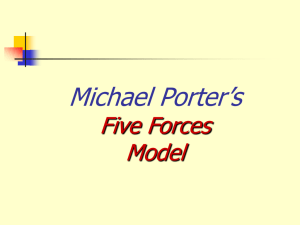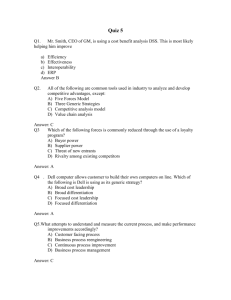Competitive advantage
advertisement
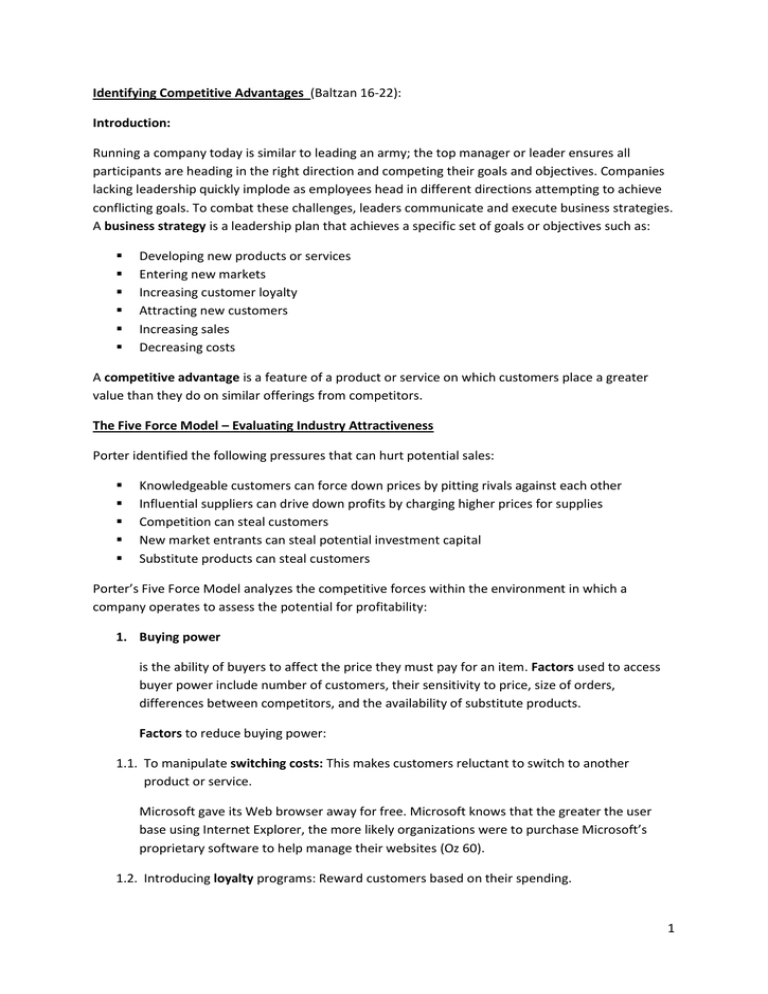
Identifying Competitive Advantages (Baltzan 16-22): Introduction: Running a company today is similar to leading an army; the top manager or leader ensures all participants are heading in the right direction and competing their goals and objectives. Companies lacking leadership quickly implode as employees head in different directions attempting to achieve conflicting goals. To combat these challenges, leaders communicate and execute business strategies. A business strategy is a leadership plan that achieves a specific set of goals or objectives such as: Developing new products or services Entering new markets Increasing customer loyalty Attracting new customers Increasing sales Decreasing costs A competitive advantage is a feature of a product or service on which customers place a greater value than they do on similar offerings from competitors. The Five Force Model – Evaluating Industry Attractiveness Porter identified the following pressures that can hurt potential sales: Knowledgeable customers can force down prices by pitting rivals against each other Influential suppliers can drive down profits by charging higher prices for supplies Competition can steal customers New market entrants can steal potential investment capital Substitute products can steal customers Porter’s Five Force Model analyzes the competitive forces within the environment in which a company operates to assess the potential for profitability: 1. Buying power is the ability of buyers to affect the price they must pay for an item. Factors used to access buyer power include number of customers, their sensitivity to price, size of orders, differences between competitors, and the availability of substitute products. Factors to reduce buying power: 1.1. To manipulate switching costs: This makes customers reluctant to switch to another product or service. Microsoft gave its Web browser away for free. Microsoft knows that the greater the user base using Internet Explorer, the more likely organizations were to purchase Microsoft’s proprietary software to help manage their websites (Oz 60). 1.2. Introducing loyalty programs: Reward customers based on their spending. 1 The airline industry is famous for its frequent-flyer programs. Because of the rewards travelers receive (free airline tickets, upgrades, or hotel stays). 2. Supplier Power A supply chain consists of all parties involved, directly or indirectly, in obtaining raw materials or a product. Supplier’s power is the ability to influence the prices they charge for supplies like materials, labor, service, etc. Factors used to appraise supplier power include number of suppliers, size of suppliers, uniqueness of services, and availability of substitute products. If supplier power is high, the supplier can influence the industry by Charging higher prices Limiting quality or services Shifting costs to industry participants Cancer patients have no power over the price and must pay whatever the drug company asks because there are few available alternatives. To reduce supplier’s power, a collective group of 15 000 students from a University has far more power over price when purchasing laptops than a single student. 3. Threat of Substitute Products or Services Is high when there are many alternatives to a product or service and low when there are few alternatives from which to choose. For example, aluminum is a substitute for steel in automobiles; trains are a substitute for cars; television and videogames are substitutes for each other. Substitutes can reduce demand for a particular type of product as customers switched to alternatives (Johnson 57). 4. Threat of new Entrants is high when it is easy for new competitors to enter a market and low when there are significant entry barriers to joining market. An entry barrier is a feature of a product or service that customers have come to expect and entering competitors must offer the same for survival. For example, a new bank must offer its customers an array of MIS-enabled services, including ATM’s, online bill paying, online account monitoring. 5. Rivalry among existing competitors The wider competitive forces all impinge on the direct competitive rivalry between an organization and its most immediate rivals. Thus low barriers to entry increase the number of rivals; powerful buyers with low switching costs force their suppliers to high rivalry in order to offer the best deals. In general then, rivalry is high when competition is fierce in a market and low when competitors are more complacent. 2 Task 1: Analyzing the airline industry: Let us bring the five forces together to look at the competitive forces shaping an industry and highlight business strategies to help it remain competitive. Assume a shipping company is deciding whether to enter the commercial airline industry. Now if analyze correctly, it will assist in determining that this move will be profitable: Buyer Power: Supplier Power: Threat of substitute products and services: Threat of new entrants: Rivalry among existing competitors: 3 Strategies: Choosing a Business focus Once top management has determined the relative attractiveness of an industry and decided to enter it, the firm must formulate a strategy for doing so. Porter has identified three generic business strategies for entering a new market: Broad cost leadership, broad differentiation and focused strategy: Cost Strategy Low Cost Broad Market Competitive Scope Narrow Market High Cost Cost Leadership Differentiation Focus Strategy Trying to be all things to all people is a recipe for disaster, since doing so makes it difficult to project a consistent image to the marketplace. Therefore, Porter suggests adopting only one of the three generic strategies. Task 2: Discuss how Information Systems can be helpful in analysing the company’s market strength. This will alter us to subtle changes and trends and generally giving us market intelligence. Supplier bargaining Power: Competitive rivalry: Buyers bargaining Power: Thread of substitutes: Threat of new entrants: Works Cited Baltzan, P. Business Driven Technology. New York: McGraw-Hill Irwin, 2013. Johnson, G., Whittington, R., Scholes, K. Exploring Strategy. Essex: Pearson, 2011. Oz, E,. Jones, A. Managemnt Information Systems. Andover: Course Technology, 2008. Stair, R., Reynolds, G., Chesney, T. Fundamentals of Business Information Systems. Hampshire: Cengage Learning, 2012. 4
